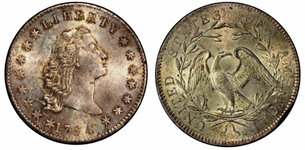A 1794 Flowing Hair silver dollar graded MS-66+ by PCGS
I personally think they Over Graded it.
to get a Higher bid.Look at the Problems around the Date. Looks like a dug Coin to me.

Professional Coin Grading Service (PCGS) realized nearly $5 million at auction Wednesday when a new portion of the D. Brent Pogue Collection went on sale in New York City. The coin had been forecasted to bring in between $3 million and $5 million. 1794 was the first year the U.S. minted silver dollars. Dennis Hengeveld noted in his of the auction that the 1794 dollar had a mintage of just 1,758 pieces and that this particular specimen is “well-known and extensively pedigreed.” The coin is known as a “Lord St. Oswald” silver dollar, so-named for the British aristocrat who first acquired the coin during travels to the U.S. around the time it was minted.
?First American Dollar? Realizes $4.9 Million at Auction | Coin Update
I personally think they Over Graded it.
to get a Higher bid.Look at the Problems around the Date. Looks like a dug Coin to me.

Professional Coin Grading Service (PCGS) realized nearly $5 million at auction Wednesday when a new portion of the D. Brent Pogue Collection went on sale in New York City. The coin had been forecasted to bring in between $3 million and $5 million. 1794 was the first year the U.S. minted silver dollars. Dennis Hengeveld noted in his of the auction that the 1794 dollar had a mintage of just 1,758 pieces and that this particular specimen is “well-known and extensively pedigreed.” The coin is known as a “Lord St. Oswald” silver dollar, so-named for the British aristocrat who first acquired the coin during travels to the U.S. around the time it was minted.
?First American Dollar? Realizes $4.9 Million at Auction | Coin Update
Amazon Forum Fav 👍
Last edited:




